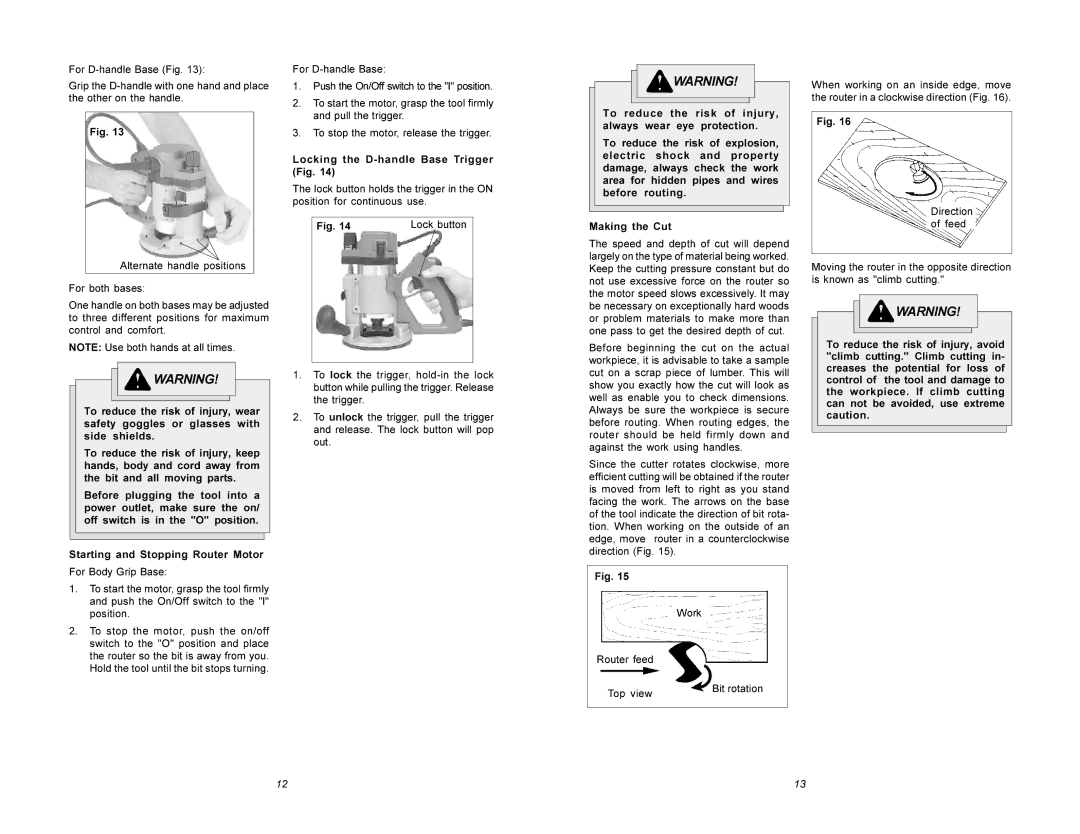
For
Grip the
Fig. 13
Alternate handle positions
For both bases:
One handle on both bases may be adjusted to three different positions for maximum control and comfort.
NOTE: Use both hands at all times.
![]()
![]()
![]() WARNING!
WARNING!
To reduce the risk of injury, wear safety goggles or glasses with side shields.
To reduce the risk of injury, keep hands, body and cord away from the bit and all moving parts.
Before plugging the tool into a power outlet, make sure the on/ off switch is in the "O" position.
Starting and Stopping Router Motor
For Body Grip Base:
1.To start the motor, grasp the tool firmly and push the On/Off switch to the "I" position.
2.To stop the motor, push the on/off switch to the "O" position and place the router so the bit is away from you. Hold the tool until the bit stops turning.
For
1.Push the On/Off switch to the "I" position.
2.To start the motor, grasp the tool firmly and pull the trigger.
3.To stop the motor, release the trigger.
Locking the D-handle Base Trigger (Fig. 14)
The lock button holds the trigger in the ON position for continuous use.
Fig. 14 | Lock button |
|
|
1.To lock the trigger,
2.To unlock the trigger, pull the trigger and release. The lock button will pop out.
![]() WARNING!
WARNING!
To reduce the risk of injury, always wear eye protection.
To reduce the risk of explosion, electric shock and property damage, always check the work area for hidden pipes and wires before routing.
Making the Cut
The speed and depth of cut will depend largely on the type of material being worked. Keep the cutting pressure constant but do not use excessive force on the router so the motor speed slows excessively. It may be necessary on exceptionally hard woods or problem materials to make more than one pass to get the desired depth of cut.
Before beginning the cut on the actual workpiece, it is advisable to take a sample cut on a scrap piece of lumber. This will show you exactly how the cut will look as well as enable you to check dimensions. Always be sure the workpiece is secure before routing. When routing edges, the router should be held firmly down and against the work using handles.
Since the cutter rotates clockwise, more efficient cutting will be obtained if the router is moved from left to right as you stand facing the work. The arrows on the base of the tool indicate the direction of bit rota- tion. When working on the outside of an edge, move router in a counterclockwise direction (Fig. 15).
Fig. 15
| Work |
Router feed |
|
Top view | Bit rotation |
|
When working on an inside edge, move the router in a clockwise direction (Fig. 16).
Fig. 16
Direction of feed
Moving the router in the opposite direction is known as "climb cutting."
![]() WARNING!
WARNING!
To reduce the risk of injury, avoid "climb cutting." Climb cutting in- creases the potential for loss of control of the tool and damage to the workpiece. If climb cutting can not be avoided, use extreme caution.
12 | 13 |
